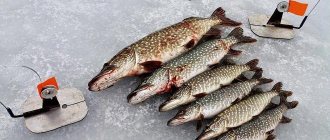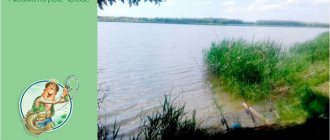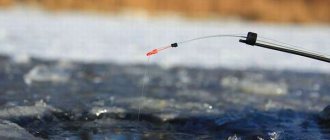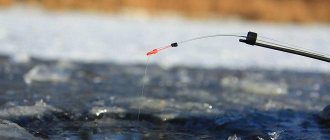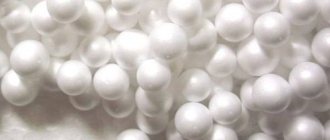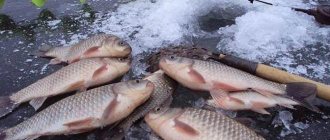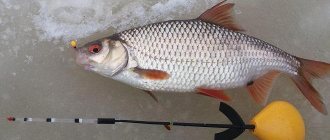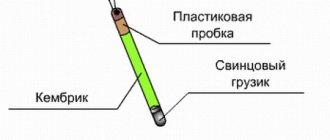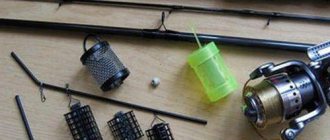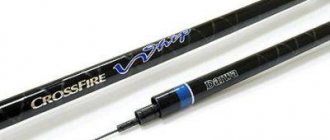To answer the question about blind rigs, you first need to decide on the fishing method. After all, blind rigs are called rigs in float fishing, feeder fishing, and carp fishing. Most often, blind installation means rigid fixation of equipment or fishing line.
For donkeys, a blind rig is such a tackle when the sinker or feeder does not slide along the fishing line. In float fishing, a blind rig is considered when the main line is attached directly to the tip of the rod, without a reel. There is also a blind float rig, when the float does not slide along the fishing line, but is rigidly fixed to it.
Blind rig for fly fishing rod
Float fishing with a fly rod is so called because a light, long rod is used without a reel, and the casting is carried out by swinging the rod.
The fishing line is attached directly to the tip of the rod, and its length can only be changed if the entire rig is remade, or if more fishing line is tied to the end.
The float in such equipment can be either sliding or deaf, more on this later in the text.
The advantages of such equipment on a moss fishing rod are:
- the tackle is very simple and light
- throw it in and out quickly
- The fishing speed with this gear is maximum.
But there are also disadvantages - a short fishing distance, as well as the inability to release the line when biting a large fish.
The total length of the blind rig with a leash should be as long as the rod itself, then landing fish will be more convenient.
As a sinker, it is recommended to use three pellets of different weights, where the heaviest pellet is located near the float, and the lightest (sub) near the leash.
Sliding equipment
Installation of any sliding float tackle, including Bolognese, includes the following steps:
- The reel is attached to the rod body via a reel seat.
- The end of the main line from the end of the fishing rod is passed through all the rings and fixed on the spool of the reel.
- A fishing line is wound onto the reel (minimum 100 m).
- The line is cut with a margin of about 2 m.
- A rubber or silicone upper stopper of the sliding equipment is placed on the free end of the fishing line and pulled to a distance of 1 m from the end (when using an inertial reel, it is better to tie a stopper knot).
- A sliding bead is placed on the end of the fishing line and pulled to the upper stopper.
- Next, a float is attached to the fishing line (at one or two points).
- After this, the sliding bead is put on again.
- The bead on the back side of the float at a distance of 0.7-0.8 m from the upper stopper is fixed with a lower stopper and a set of weights (for still water or for current).
- The end of the fishing line is formed into a loop for tying a leash.
- A leash is attached to the fishing line through a swivel.
When fishing in deep water and far from the shore of a reservoir, a sliding float becomes indispensable, despite the emergence of new modern gear and fishing methods. Since large fish often stand in the middle of the riverbed, long casting can be easily accomplished in this way.
Using a match rod and a blind float attachment will not help in this situation, since the depth of the water will be greater than the length of the rod. It turns out that at significant depths and long casting distances, the only way out will be a sliding float.
It will also be very useful when fighting against strong currents, including at depths of up to 4 m. After all, when you need to cast 20-30 meters from the shore, it is impossible to cast floats with blind mounts with high accuracy.
Additional benefits
Sliding mounting allows the floats to move freely along the rig from stopper to stopper. Depending on the model, the fishing line is passed through a ring or hole in the body of the float.
https://youtube.com/watch?v=eGscrIFfy9A
Stoppers for sliding installation are used from different materials:
- Rubber. Silicone rubber beads are the best at absorbing shock and protecting floats. It is better to place several silicone tips in a row to prevent shifting.
- Plastic beads. They are easy to put on the fishing line and move freely along it. The bead attachment is secured with locking knots. To soften the blows, cambrics are placed in front of the beads.
- A thread. Special thread stoppers with beads are sold. Such stoppers often become loose and have to be constantly tightened.
- Lead pellets. In case of urgent need and the absence of other stoppers, you can use sinker pellets, clamping them above and below the float. In this case, it would be correct to use cambrics to soften the impacts of pellets on the fastening elements of the structure.
When using this or that stopper, you need to pay attention to how it will pass through the guides of your rod when casting
Blind float equipment
Let us repeat that the blind rigging of the float itself means that the float does not slide, but is held fixedly on the fishing line due to the high friction between the fishing line and the float.
This effect can also be achieved by using two stoppers, which are pressed closely to the float and completely limit its movement.
My personal opinion is that it is better to use a sliding float, as when casting the float is at the very bottom, which is convenient. It is easier to make long casts, as well as casts in strong crosswinds.
Bottom blind rigs
If we consider rigs for donkeys, then in this case, blind rigs are those rigs in which the sinker or feeder does not slide along the main line, that is, it is rigidly fixed. The advantage of a blind rig is that when it bites, the fish is hooked on its own under the weight of the sinker or feeder. That is, the fish grabbed the bait with the hook in its mouth, pricked, twitched and thereby got caught under the weight of the equipment’s load. If you want to find out more information about carp rigs, we recommend visiting our colleague’s website - https://f1sh1ng.ru/lovlya/karp/montazhi.html a great informative article for carp and bottom fishers.
Types of fishing rods
There are several types of fishing rods with floats:
A fly rod that is about 7 meters in length. It does not have a reel or only a small drum to store the fishing line. This equipment is very easy to throw into a pond.
Read here Offset hook: installation, practical advice on choosing and review of suitable baits (100 photos + video)
Match fishing rod. Her rod is about 6 meters. It is needed for long-distance casting of the float. There may be a sliding float fishing rod, as well as a blind one.
You can also fish using the plug method. This is a very long rod. It can be up to 20 meters in length.
Blind carp equipment
Blind equipment is not exactly considered sporting, but it is most often used in carp fishing, when you have to wait a very long time for a bite and there is no opportunity to constantly be near the rod.
The leash for blind mounting is usually short, about 10 cm long. Blind mounting is used both with method feeders and with hair rigs for boilies with a sinker.
Blind equipment for feeder
In feeder fishing, blind equipment is also used, but to a lesser extent. This is due to the fact that feeder fishing involves timely hooking by the fisherman and frequent bites of small and medium-sized fish. It happens that the fish bites very carefully and does not get caught, in this case it is recommended to change the equipment to a sliding one, with a longer leader.
Selection and installation of gear
The rod consists of a blank divided into segments. The smaller the number of sections, the lighter the weight of the fishing gear. The main quality criterion, which also affects the weight, is the material. The best models are made from carbon fiber, a durable and ultra-light raw material; many manufacturers use fiberglass and composite (a hybrid obtained by using several elements). One of the most famous is the Mikado company. The next parameter is length. First of all, the growth of the fishing rod depends on the fishing location: if the edge is close to the shore, you need to start fishing here, since underwater inhabitants prefer to stick to such bottom irregularities. An excellent solution would be a plug-in model, in which one or two elbows can be removed if necessary. As a rule, they are produced up to 11 m long.
Advantages of fly fishing:
- minimum weight of the rod that even a child can handle;
- instant replacement of equipment if ready-made installations are available;
- quick research of both coastal and distant fishing zones;
- accurate and silent casting to the baited area;
- functionality and wide range of applications;
- constant contact between the angler and the rod.
Fishing with a fly rod does not involve the use of reels. The fishing line is attached to a special device - a rod connector. It is structurally reminiscent of a small bushing, which is glued into the whip (if a shock absorber is not used) and has a hook for the loop. Ready-made leashes with various options for loading and equipment are convenient to store and transport in leash holders; some fishermen use small reels. In the event of a break, the installation can be re-equipped in a matter of minutes. The diameter of the fishing line depends on the size of the intended trophy and hook. Fishing rod floats are sliding floats, with a long guide tube for catching small fish and a high antenna for long distances and deep places. Shot weights are placed along the entire length of the leash. Proper loading increases the sensitivity of the tackle and distributes the test weight of the float among themselves.
The simplest equipment is to attach the leash directly to the connector, but when hunting for a decent trophy, you should use a rubber shock absorber. The element has different densities and stretch lengths, and is capable of dampening the jerks of large fish, such as carp and grass carp, performing the functions of a friction clutch.
Installation Tips
Fishing in still waters is characteristically different from fishing in flowing waters. On a pond, an angler can use small weights that would be easily pulled by the current on a river. The fly rod is used in both situations; only the equipment is adjusted. The thickness of the leader when fishing with a retrieve is significantly reduced, since the fish is in direct contact with the line and feels the roughness. The installation can be equipped with an additional hook, so different depths can be fished with one wire. The float is used in a sports class, with a test weight of up to 2 g. It is attached using tubes placed on the keel and a small ring built into the body.
To learn more:
What is fluorocarbon fishing line and how is it used?
The shape depends on the fishing method - when searching for fish, elongated models are used for fishing, and for stationary fishing you will need a streamlined spherical alarm. Fishing in still water does not require such delicacy. The main weight is placed at the bottom, at a distance of 5 cm from the hook, so the fish does not feel the line. Blind equipment is more popular than sliding equipment. The connector for the fishing rod is selected according to the size of the cavity of the whip, it should fit closely into it.

